Ask a question from expert
Technical and Vocational Institute PDF
29 Pages7311 Words268 Views
Added on 2021-11-23
Technical and Vocational Institute PDF
Added on 2021-11-23
BookmarkShareRelated Documents
Technical and Vocational Institute
Centre No.: 91043
1
BTEC
RQF – Assignment Brief (16)
Qualification: BTEC Level 5 HND in Electrical and Electronic Engineering
Student Name/ID Number Mohamed Ahmed Abd El-Hamid El-Agamey / 19103951
Unit Number and Title 15 Automation, Robotics and Programmable Logic Controllers
Unit Learning Outcome LO1:Describe the design and operational characteristics of a
PLC system
LO2:Design a simple PLC program by considering PLC
information, programming and communication techniques
Academic Year 2020/2021
Unit Assessor Eng. Mustafa osman
Assignment title
Issue Date
Submission Date
IV Name Eng. Amr Khamis
Date
Student Declaration
Declaration
“I certify that the assignment submission is entirely my own work, and I fully understand the
consequences of plagiarism. I understand that making a false declaration is a form of
malpractice.”
Student Name: Student Signature:
Submission Format:
• For task2 point 1: student need to make program and simulate it by using any PLC software
then takes screen shot for this program then put it at the same written report and explain the
program by an oral discussion.
• For whole report: The submission is in the form of an individual written report using the Harvard
referencing system. The recommended word limit is 1000–1500 words. You will not be penalised
for exceeding the total word limit.
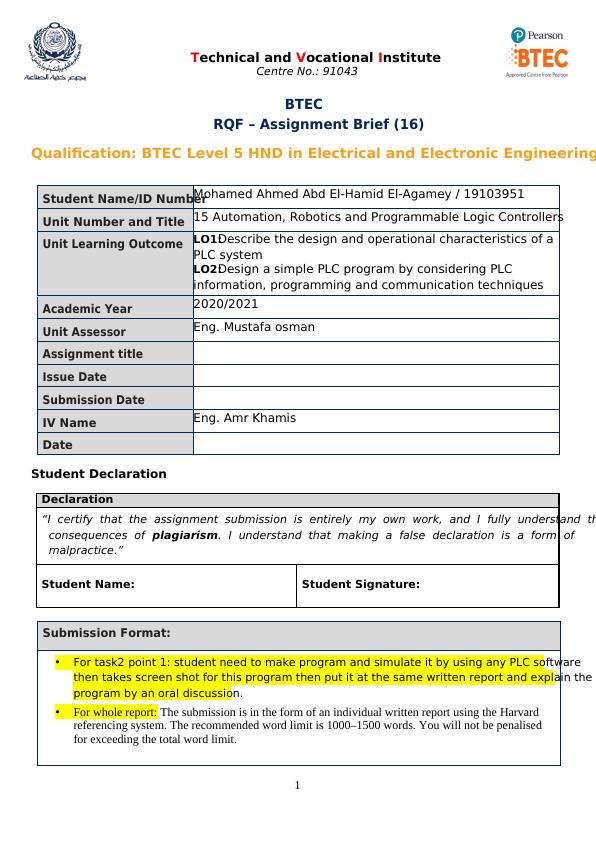
Technical and Vocational Institute
Centre No.: 91043
2
Task 1 :
For Mixer system shown in the following figure. The system has a PLC connected to HMI which is used to control
and monitor the process. The mixer has a tank with 1m depth, 2 solenoid valves to enter liquid A and B, mixing
motor, level sensor 0.1 m/V, temperature sensor with 10 C/V, start push button, stop push button and emergency
stop button.
For this system, answer the following questions:
• Describe PLC construction styles that can be used for this system or for any other application
Programmable Logic Controller
The digital device used for industrial automation to automate various electro-mechanical processes is a PLC
(programmable logic controller). It was implemented to remove problems that resulted from the use of relays to
control production processes, such as high power consumption. This consists of a programmed microprocessor
whose software is written on a device and subsequently downloaded to the PLC via a cable. The software is stored
in a PLC memory that is non-volatile and have more types of PLC like Compact, Modular and unitary.
(Fabrice Boisset, General Manager, Europe, Middle East, Africa Region, 2018)
Compact PLC In Compact PLC, the manufacturer repairs and decides I/O capability. For small
scale applications, they are used.
The numerous built-in modules have a single example. Power supply, CPU, I/O
interfaces and all parts are housed in a compact mood. Some types of this module
designed to load extra module. (Sivaranjith, 2019)
PROGRAMMING
Programming and configuration are carried out by means of a USB port. The
PLCs of the C series come in three regular lengths and with different numbers and
forms of IO.
BUILDING AUTOMATION
The Compact Series PLCs represent a modern solution for the task of building automation, such as: Fan Coil
Controller, Roof Top Controller, Air Handling Unit, Office Controller, Home Controller, etc.
Compact PLCs can be a versatile and effective solution for Guest Room Management Systems with additional
equipment, such as a thermostat, RFID card reader and holder.
C SERIES PLC TYPES
• Digital Input Modules
• Digital Output Modules
• Digital Input/output Modules
• Functional Controllers
• Lighting Controllers
• Power Supply Modules (euroicc, 2020)
Figure 1
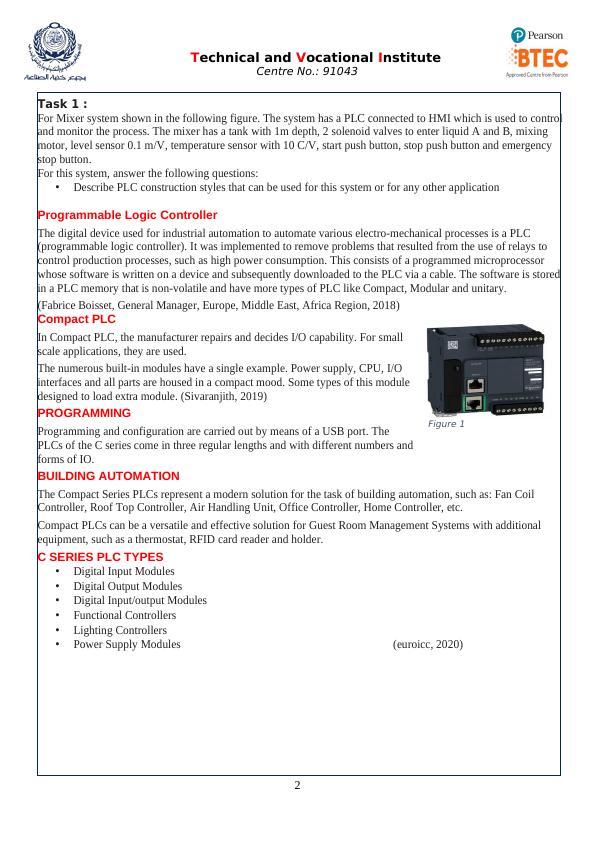
Technical and Vocational Institute
Centre No.: 91043
3
Modular PLC
Modular PLC is made up of several modules that are plugged into a standard rack,
such as CPU, I/O modules, and power modules. It can extend the capabilities of the
I/O. The modular PLC is versatile and can be designed for the task. With variable
power supply, computing capability, I/O networking, etc., (Sivaranjith, 2019)
Modular PLC Design and Characteristics
Modular PLCs are a series of modules to create a system that can be slotted together. Elementary modules
contain;
• A power supply.
• The main module which contains a central processing unit (CPU).
• The input module.
• The output module
Other module types, as well as additional input and output modules, may be attached to improve flexibility or to
cope with hardware device changes.
The advantages of a modular PLC:
• To deal with any improvements to the hardware system, the quantity of input and output terminals may be
increased.
• If any function fails, only that portion needs to be altered to save on costs.
The disadvantages of a modular PLC:
• Compared to unitary PLC's, they are costly
Applications
For applications where there will be a lot of inputs and outputs, modular PLC's are useful because if appropriate,
further input/output modules could be added. This form of PLC is commonly used to manage process lines in the
manufacturing industry. (ukessay, 2017)
Figure 2
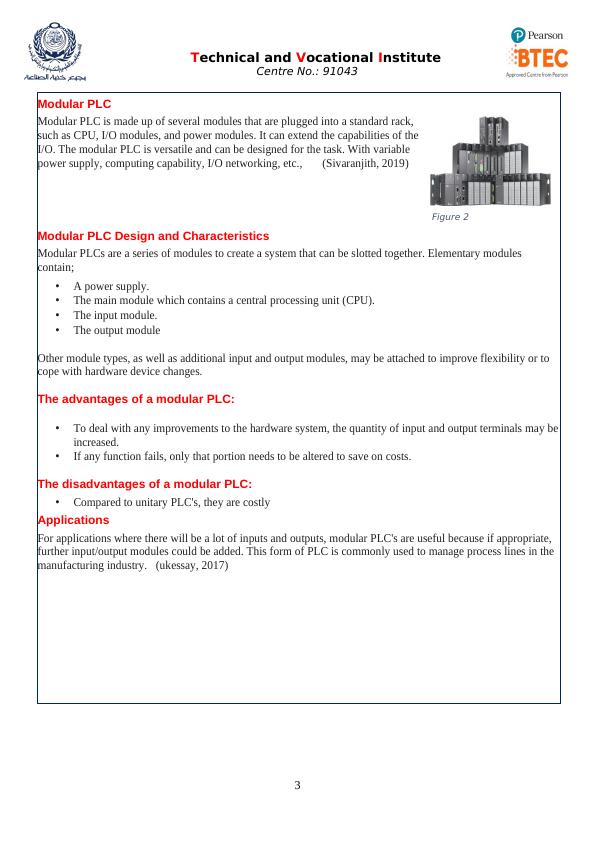
Technical and Vocational Institute
Centre No.: 91043
4
Unitary PLC The simpler type of controller, and inside a single housing, or box, contains all the
basic device components. In addition to ports for input and output connections,
these modules usually include the processor, which runs the software program.
Usually, unitary PLCs are connected directly to the controlled system or
application. (Aries, 2018)
Unitary PLC Design and characteristics
In one compact unit, a Unitary PLC incorporates all the features of a simple framework, including;
• A power supply.
• The main module which contains a central processing unit (CPU).
• The input module.
• The output module
The advantages of a unitary PLC:
• They are lightweight and thin.
• In one unit, they carry all the essential components.
• They enable simple, portable access to
• They are the cheapest sort of PLC, normally
The disadvantages of a unitary PLC:
• It is not necessary to extend them.
• The whole device has to be replaced if any function fails.
Applications
For any application that does not involve a lot of inputs or outputs, unitary PLCs can be used. This does not
use several inputs/outputs and would only require a basic programme, for example, a car park barrier.
(ukessay, 2017)
Figure 3
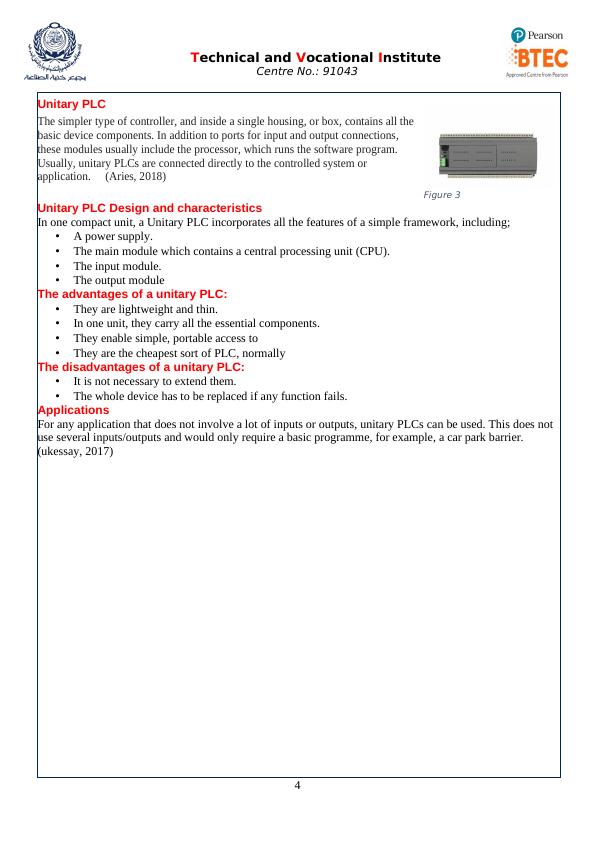
Technical and Vocational Institute
Centre No.: 91043
5
• analyse the internal architecture for the selected PLC
Centre Process Unit:
The processor's main role is to control the entire system's activities. It performs this purpose by interpreting a set
of machine programs and executing them. The machine program is permanently stored in the processor and is
considered a component of the controller itself. (mel, 2014)
Buses:
A high-speed internal connection is a bus. Buses are used between the processor and other elements to send
control signals and data. It uses three types of bus:
• Address bus - carries memory addresses to other parts, such as primary storage and input/output devices,
from the processor. The bus to the address is unidirectional.
• Data bus - carries information between the processor and other parts of the processor. The bidirectional
data bus is.
• Control bus - carries the processor control signals to other elements. The control bus holds the pulses of
the clock as well. Unidirectional is the control bus. (BBC, 2020 )
Figure 4
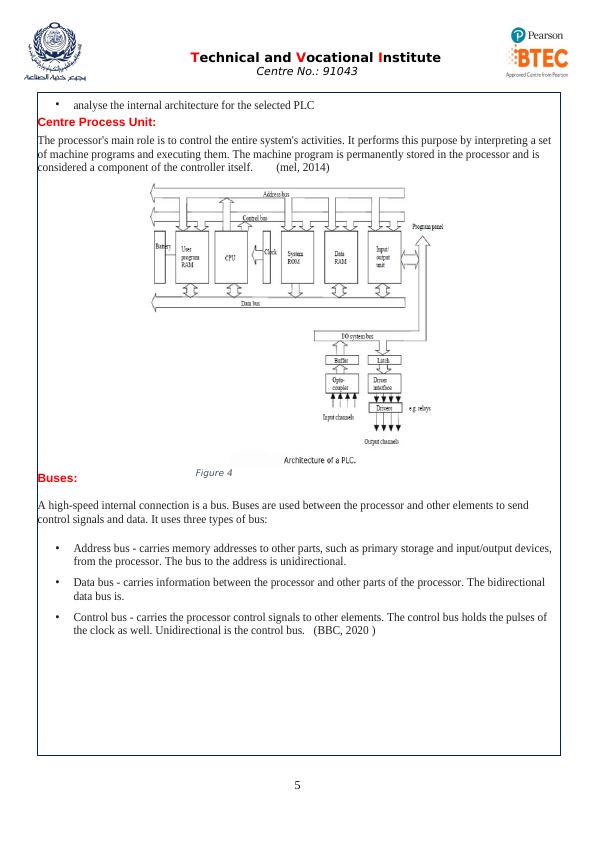
Technical and Vocational Institute
Centre No.: 91043
6
Memory:
There is a need for it to access the data to be processed and instructions for running the PLC system i.e. the
software, which tells it on how to process the data. They are both processed for access during processing in the
PLC memory. In a PLC scheme, many memory elements exist:
• Device Read-only-Memory (ROM) provides the operating system with permanent storage and fixed data
used by the CPU.
• For the user's software, random-access memory (RAM) is used.
• For data, random-access memory (RAM) is used. This is where the status of input and output devices and
the values of timers and counters and other internal devices are stored in information. The RAM of data is
often referred to as a table or register table of data. For input and output addresses and the states of those
inputs and outputs, part of this memory, that is, a block of addresses, will be set aside. For pre-set data,
part will be set aside and part will be set to store counter values, timer values. (Wisdom IT Services India
Pvt. Ltd, 2020)
Figure 5

End of preview
Want to access all the pages? Upload your documents or become a member.
Related Documents
PLC Assignment: Types, Input and Output Devices, Communication Links, Programming Languages, and Internal Architecturelg...
|2
|1149
|64
Technical Education Centre for Online Learning Assessment 2022lg...
|15
|3167
|29